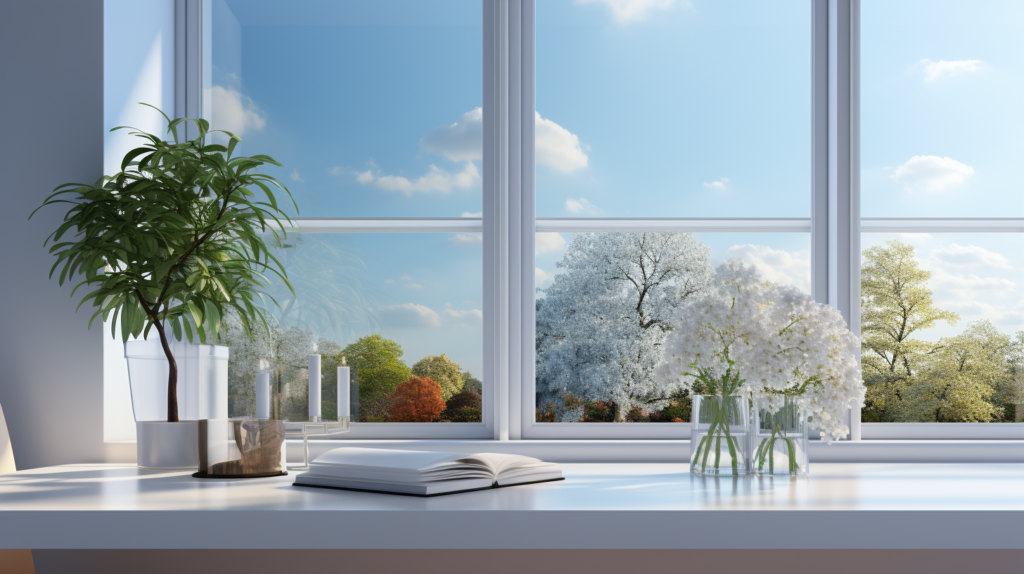Ever wondered if the buzz of the outside world can be silenced by double glazed windows?
This question resonates with anyone craving tranquility in their urban havens.
With a design that incorporates two layers of glass, these windows promise to dampen the din of daily life.
As we delve into the world of double-glazed windows, we’ll dissect their soundproofing claims and measure their true effectiveness.
Let’s dive in and see if they truly offer the serene escape we seek from the noise beyond our walls.
Understanding Soundproofing

The concept of soundproofing is grounded in the science of acoustics, particularly the branch that deals with noise control within buildings.
It involves the use of materials and construction techniques to reduce the transmission of sound from one space to another or from the outside to the inside of a building.
In the bustling noise of modern living, where the sounds of urban environments are ever-present, the value of a quiet interior space cannot be overstated.
Soundproofing helps to create environments that foster relaxation, concentration, and privacy, which are essential for residential and commercial spaces alike.
Effective soundproofing incorporates a variety of materials that absorb, reflect, or dampen sound waves.
These materials range from dense insulation within walls to specialized acoustic panels that can be installed in rooms where sound control is paramount.
For many city dwellers and those living in noisy neighborhoods, soundproofing has become an essential component of home improvement projects.
Windows are often identified as one of the main vulnerabilities in a building’s defense against external noise.
Unlike walls, which can be thick and insulated, windows must balance the need for visibility and light with the need for sound reduction.
Traditional single-pane windows offer little resistance to noise, and as a result, they are a significant source of noise pollution in homes and offices.
The challenge of soundproofing windows is exacerbated by the fact that they are subject to various operational stresses, such as opening and closing, which can affect the integrity of their seal over time.
Furthermore, the materials commonly used for window frames and glass are naturally hard surfaces that can reflect and sometimes even amplify sound waves.
This makes the pursuit of effective window-based soundproofing a critical focus for architects, builders, and homeowners seeking solace from the noisy world outside.
What Is Double Glazed Windows And How Is Double Glazed Window Made

Double glazed windows, which are also referred to as dual-pane or insulated glass, are an advanced window design that incorporates two pieces of glass with an air or gas-filled space in between.
This design is a step up from traditional single-pane windows, offering improved thermal insulation and soundproofing capabilities.
The principle behind double glazing is to provide a buffer zone that can act as a barrier to heat flow and noise.
The structure of these windows is key to their performance.
The two panes of glass are separated by a spacer, which is filled with desiccants to absorb internal moisture and sealants are applied to prevent the exchange of air and moisture between the inside and outside.
These windows are carefully crafted to ensure that the inert gas remains trapped between the panes, maintaining their insulating properties over time.
The Production Process
The manufacturing of double glazed windows is a process that requires precision engineering and quality materials.
It begins with cutting the glass to the precise dimensions required for the window frames. The glass panes are then cleaned and prepared for assembly.
Spacers are placed around the edges of one pane of glass, creating the framework for the gap between the panes.
These spacers often contain a desiccant that helps to absorb any moisture trapped during manufacture.
Once the spacer is affixed, the second pane of glass is placed on top, and the two are sealed together to create a single unit.
Before sealing, the space between the glass is often filled with an inert gas, such as argon or krypton, which provides better insulation than air.
The entire unit is then sealed, creating an airtight and moisture-free space that enhances the window’s insulating properties.
High-tech sealants are used to ensure the longevity of the seal and to prevent condensation or the ingress of moisture, which could compromise the window’s performance.
How Does Double Glazed Windows Stop Noise

Double glazed windows impede noise through a multi-faceted approach. The primary mechanism is the interruption of the sound wave path, which occurs when sound waves hit the first pane of glass and are partially reflected back, partially absorbed by the glass, and partially transmitted through to the air gap.
The air gap then acts as an insulating layer; it slows the sound waves down because air (or the inert gas within the space) is a less effective conductor of sound than solids.
As sound waves enter the second pane of glass, a further reduction in noise occurs due to additional absorption and reflection.
This dual-barrier system thus significantly reduces the amount of noise that can pass through the window.
Moreover, the density and thickness of the glass play a vital role in the window’s sound dampening capacity.
Thicker glass panes will generally offer better sound insulation due to their greater mass, which hinders the vibration caused by sound waves.
Similarly, the type of gas used in the gap can also affect sound insulation; denser gases like argon and krypton are better at reducing sound transmission than lighter gases or air.
Advanced Features For Noise Reduction
In pursuit of even greater sound reduction, window manufacturers have developed advanced features that can be incorporated into double glazed windows.
One such feature is laminated glass, which consists of two glass layers bonded together with a plastic interlayer.
The interlayer acts as a dampening core, absorbing and dissipating the energy of the sound waves. This can be particularly effective against low-frequency noises, which are typically the hardest to mitigate.
Another technique is to vary the thickness between the two panes of glass. By using panes of different thicknesses, the window can target a broader range of sound frequencies.
Thicker glass can block lower frequencies, while the combination with a thinner pane can disrupt higher-frequency sound waves.
Additionally, treating the surface of the glass with coatings that enhance its sound dampening properties has become increasingly common.
These coatings can reduce the vibrational energy that passes through the glass, thus improving the window’s overall soundproofing effectiveness.
What Is The STC Of Double Glazed Windows

Double-glazed windows have STC ratings that typically range from 25 to 35, depending on their construction and the materials used.
An STC rating in this range indicates that the window can reduce noise by 25 to 35 decibels, which can perceptibly quieten the sounds of urban environments.
For instance, a conversation that might be easily heard through a single-pane window with an STC rating of 20 might be reduced to a murmur with a double-glazed window having an STC rating of 30.
It is important to understand that the STC rating does not scale linearly with decibels; an increase in the STC rating represents a logarithmic reduction in sound transmission.
This means that a window with an STC rating of 30 does not reduce noise twice as much as a window with an STC rating of 15.
Moreover, while higher STC ratings indicate better sound reduction, they are not the sole determinant of a window’s overall performance in a real-world setting.
Factors such as the quality of installation, the type of frame, and the presence of any gaps or leaks can significantly affect the actual soundproofing performance of a window.
What’s The Difference Between Double Glazed Windows And Double Pane Windows

The terms ‘double glazed’ and ‘double pane’ are often used interchangeably, but they can lead to confusion.
In essence, both terms describe a window that uses two panes of glass to create a single window unit.
However, the term ‘double glazed’ typically refers to windows that have additional features for insulation — such as the presence of an inert gas like argon between the panes or a coating that reflects heat.
‘Double pane,’ on the other hand, generally refers to the physical description of having two layers of glass, without specifying the presence of these additional insulating features.
Misconceptions arise when consumers are presented with these terms without proper explanation, leading to the belief that they represent different levels of quality or performance.
Manufacturers and retailers must provide clear definitions to ensure customers understand exactly what they are purchasing and how it will perform in terms of energy efficiency and soundproofing.
Factors That Affect Performance
While the basic construction of double pane and double glazed windows is similar, the performance of the windows can vary widely based on the quality of materials and construction.
The spacer material, type of inert gas used, and the quality of the sealant all play significant roles in determining the window’s insulating abilities.
For example, a double glazed window with a stainless steel spacer, argon gas fill, and a high-quality sealant will generally perform better in terms of soundproofing and thermal insulation than a double pane window with an aluminum spacer and no gas fill.
The performance of the windows is also influenced by additional treatments to the glass.
Coatings, such as low-emissivity (low-E) coatings, can be applied to the surface of the glass to reflect heat and UV rays, thereby enhancing the thermal performance of the window.
These coatings can also have a marginal effect on the soundproofing qualities of the window by changing the vibrational characteristics of the glass.
Limitations Of Double Glazed Windows In Terms Of Soundproofing

No soundproofing solution is perfect, and double-glazed windows are no exception. They significantly reduce noise levels but cannot completely eliminate all external sounds.
The performance of double-glazed windows in soundproofing is contingent upon the frequency and intensity of the noise.
High-frequency sounds, like birds chirping or children playing, are generally well mitigated by double-glazed windows.
However, the windows are less effective against low-frequency noises, such as the drone of airplane engines or the thump of bass music, which can penetrate through even the most robust barriers.
The effectiveness of double glazed windows in soundproofing also depends on the overall construction of the building.
Sound can transmit through other weak points in a structure, such as gaps in the building envelope, doors, and even through vents and ductwork.
For a building to be truly soundproof, attention must be given to all these potential pathways for sound transmission, not just the windows.
Installation Issues
The best double glazed windows can be rendered less effective if not installed correctly
If the window frame does not fit perfectly into the building envelope, or if the sealant used to fix the window in place is of poor quality, gaps can occur.
These gaps, however small, are enough to allow sound waves to penetrate, undermining the soundproofing qualities of the window.
Proper installation by skilled professionals is essential to ensure that the windows perform as intended.
Material Matters
The materials used to construct the window frame also contribute to the soundproofing capabilities of double glazed windows.
Metal frames, while strong and durable, are more prone to conducting sound than wood or uPVC. The frame’s design, including the quality of insulation used within the frame itself, also affects the sound transmission.
Advanced window frames are designed with multiple chambers that trap air and create additional barriers to sound, enhancing the overall soundproofing of the window.
How To Make Double Glazed Windows More Soundproof

To maximize the soundproofing capabilities of double-glazed windows, proper sealing is imperative.
Over time, the sealant that holds the window unit together can degrade, leading to the potential for air leaks and a reduction in soundproofing.
Homeowners can address this by using acoustic caulk to fill any gaps that appear between the window frame and the building structure.
This not only prevents air leaks but also adds an extra layer of sound dampening.
For those in particularly noisy environments, combining these enhancements with other soundproofing measures can lead to a significant reduction in noise levels.
Adding thick curtains or window treatments that have sound-absorbing properties can further dampen any noise that does manage to penetrate the double glazed windows.
For the most effective soundproofing, these measures should be part of a comprehensive approach that includes addressing any other weak points in a building’s acoustic barrier.
Conclusion
Double glazed windows are a modern solution to the age-old problem of noise pollution, providing a significant reduction in unwanted sound and an enhancement to our indoor environments.
They underscore the importance of acoustic comfort in our homes and workplaces, allowing for spaces where peace and quiet facilitate relaxation and focus.
Although perfect silence is unattainable, double glazed windows come impressively close, especially when integrated into a comprehensive soundproofing strategy.
Their effectiveness is contingent on quality installation and maintenance, but the acoustic benefits they offer make them a smart investment for those seeking respite from the noisy world outside.
By prioritizing such soundproofing solutions, we prioritize our comfort and well-being, ensuring our living spaces remain havens of calm in an otherwise bustling world.
